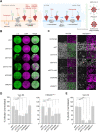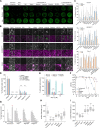Inhibition of Protein N- Glycosylation Blocks SARS-CoV-2 Infection
- PMID: 35164559
- PMCID: PMC8844921
- DOI: 10.1128/mbio.03718-21
Inhibition of Protein N- Glycosylation Blocks SARS-CoV-2 Infection
Abstract
Severe acute respiratory syndrome coronavirus-2 (SARS-CoV-2) extensively N-glycosylates its spike proteins, which are necessary for host cell invasion and the target of both vaccines and immunotherapies. These N-glycans are predicted to modulate spike binding to the host receptor by stabilizing its open conformation and host immunity evasion. Here, we investigated the essentiality of both the host N-glycosylation pathway and SARS-CoV-2 N-glycans for infection. Ablation of host N-glycosylation using RNA interference or inhibitors, including FDA-approved drugs, reduced the spread of the infection, including that of variants B.1.1.7 (Alpha), B.1.351 (Beta), P.1 (Gamma) and B.1.617.2 (Delta). Under these conditions, cells produced fewer virions and some completely lost their infectivity. Furthermore, partial enzymatic deglycosylation of intact virions showed that surface-exposed N-glycans are critical for cell invasion. Altogether, we propose protein N-glycosylation as a targetable pathway with clinical potential for treatment of COVID-19. IMPORTANCE The coronavirus SARS-CoV-2 uses its spike surface proteins to infect human cells. Spike proteins are heavily modified with several N-glycans, which are predicted to modulate their function. In this work, we show that interfering with either the synthesis or attachment of spike N-glycans significantly reduces the spread of SARS-CoV-2 infection in vitro, including that of several variants. As new SARS-CoV-2 variants, with various degrees of resistance against current vaccines, are likely to continue appearing, halting virus glycosylation using repurposed human drugs could result in a complementary strategy to reducing the spread of COVID-19 worldwide.
Keywords: COVID-19; N-glycosylation; SARS-CoV-2; antiviral agents; coronavirus; glycosylation; viral infection.
Conflict of interest statement
The authors declare no conflict of interest.
Figures





Similar articles
-
Analysis of Glycosylation and Disulfide Bonding of Wild-Type SARS-CoV-2 Spike Glycoprotein.J Virol. 2022 Feb 9;96(3):e0162621. doi: 10.1128/JVI.01626-21. Epub 2021 Nov 24. J Virol. 2022. PMID: 34817202 Free PMC article.
-
Inhibition of SARS-CoV-2 viral entry upon blocking N- and O-glycan elaboration.Elife. 2020 Oct 26;9:e61552. doi: 10.7554/eLife.61552. Elife. 2020. PMID: 33103998 Free PMC article.
-
Analysis of the Role of N-Linked Glycosylation in Cell Surface Expression, Function, and Binding Properties of SARS-CoV-2 Receptor ACE2.Microbiol Spectr. 2021 Oct 31;9(2):e0119921. doi: 10.1128/Spectrum.01199-21. Epub 2021 Sep 8. Microbiol Spectr. 2021. PMID: 34494876 Free PMC article.
-
Glycosylation of SARS-CoV-2: structural and functional insights.Anal Bioanal Chem. 2021 Dec;413(29):7179-7193. doi: 10.1007/s00216-021-03499-x. Epub 2021 Jul 7. Anal Bioanal Chem. 2021. PMID: 34235568 Free PMC article. Review.
-
Glycosylation is a key in SARS-CoV-2 infection.J Mol Med (Berl). 2021 Aug;99(8):1023-1031. doi: 10.1007/s00109-021-02092-0. Epub 2021 May 22. J Mol Med (Berl). 2021. PMID: 34023935 Free PMC article. Review.
Cited by
-
Principles of SARS-CoV-2 glycosylation.Curr Opin Struct Biol. 2022 Aug;75:102402. doi: 10.1016/j.sbi.2022.102402. Epub 2022 May 19. Curr Opin Struct Biol. 2022. PMID: 35717706 Free PMC article. Review.
-
Coronavirus accessory protein ORF3 biology and its contribution to viral behavior and pathogenesis.iScience. 2023 Apr 21;26(4):106280. doi: 10.1016/j.isci.2023.106280. Epub 2023 Feb 28. iScience. 2023. PMID: 36945252 Free PMC article. Review.
-
Strategic self-limiting production of infectious HIV particles by CRISPR in permissive cells.Mol Ther Nucleic Acids. 2023 May 19;32:1010-1025. doi: 10.1016/j.omtn.2023.04.027. eCollection 2023 Jun 13. Mol Ther Nucleic Acids. 2023. PMID: 37346975 Free PMC article.
-
Traversing the Cell Wall: The Chitinolytic Activity of Histoplasma capsulatum Extracellular Vesicles Facilitates Their Release.J Fungi (Basel). 2023 Oct 27;9(11):1052. doi: 10.3390/jof9111052. J Fungi (Basel). 2023. PMID: 37998859 Free PMC article.
-
Interferon-Inducible Guanylate-Binding Protein 5 Inhibits Replication of Multiple Viruses by Binding to the Oligosaccharyltransferase Complex and Inhibiting Glycoprotein Maturation.bioRxiv [Preprint]. 2024 May 3:2024.05.01.591800. doi: 10.1101/2024.05.01.591800. bioRxiv. 2024. PMID: 38746287 Free PMC article. Preprint.
References
-
- Lu R, Zhao X, Li J, Niu P, Yang B, Wu H, Wang W, Song H, Huang B, Zhu N, Bi Y, Ma X, Zhan F, Wang L, Hu T, Zhou H, Hu Z, Zhou W, Zhao L, Chen J, Meng Y, Wang J, Lin Y, Yuan J, Xie Z, Ma J, Liu WJ, Wang D, Xu W, Holmes EC, Gao GF, Wu G, Chen W, Shi W, Tan W. 2020. Genomic characterisation and epidemiology of 2019 novel coronavirus: implications for virus origins and receptor binding. Lancet 395:565–574. doi:10.1016/S0140-6736(20)30251-8. - DOI - PMC - PubMed
-
- Hoffmann M, Kleine-Weber H, Schroeder S, Krüger N, Herrler T, Erichsen S, Schiergens TS, Herrler G, Wu N-H, Nitsche A, Müller MA, Drosten C, Pöhlmann S. 2020. SARS-CoV-2 cell entry depends on ACE2 and TMPRSS2 and is blocked by a clinically proven protease inhibitor. Cell 181:271–280. doi:10.1016/j.cell.2020.02.052. - DOI - PMC - PubMed
MeSH terms
Substances
Supplementary concepts
Grants and funding
LinkOut - more resources
Full Text Sources
Medical
Research Materials
Miscellaneous

